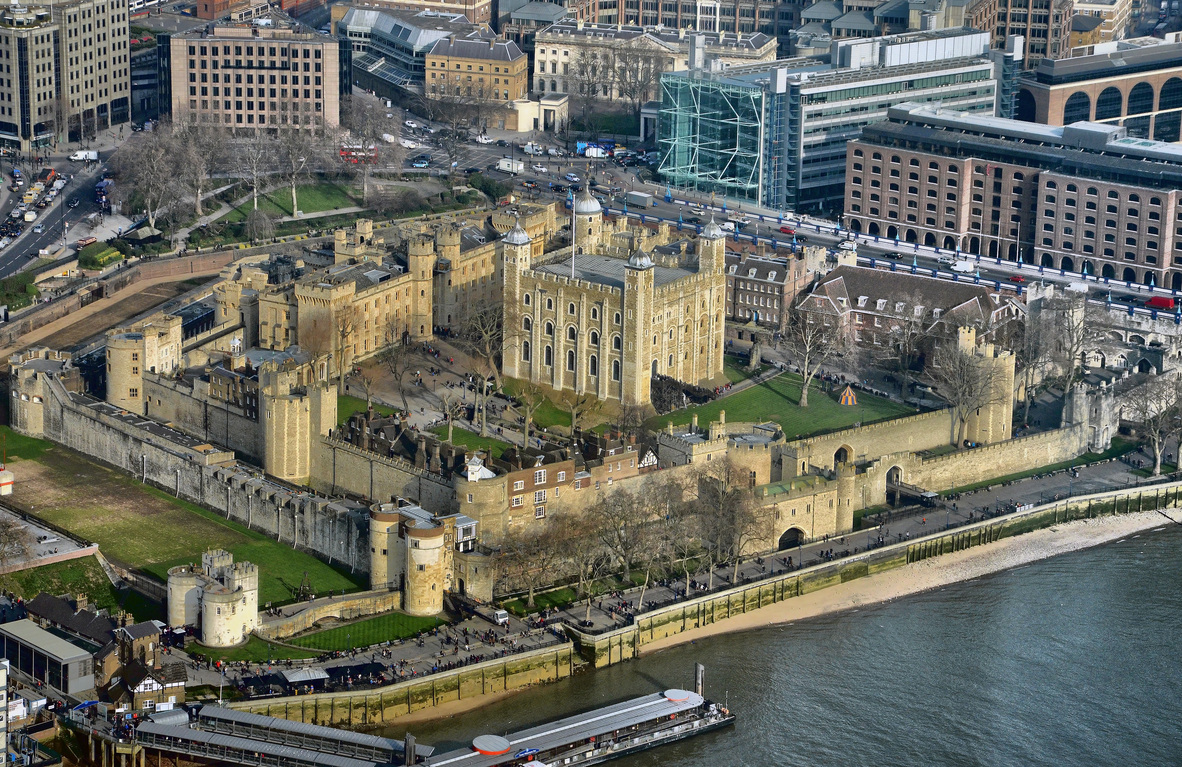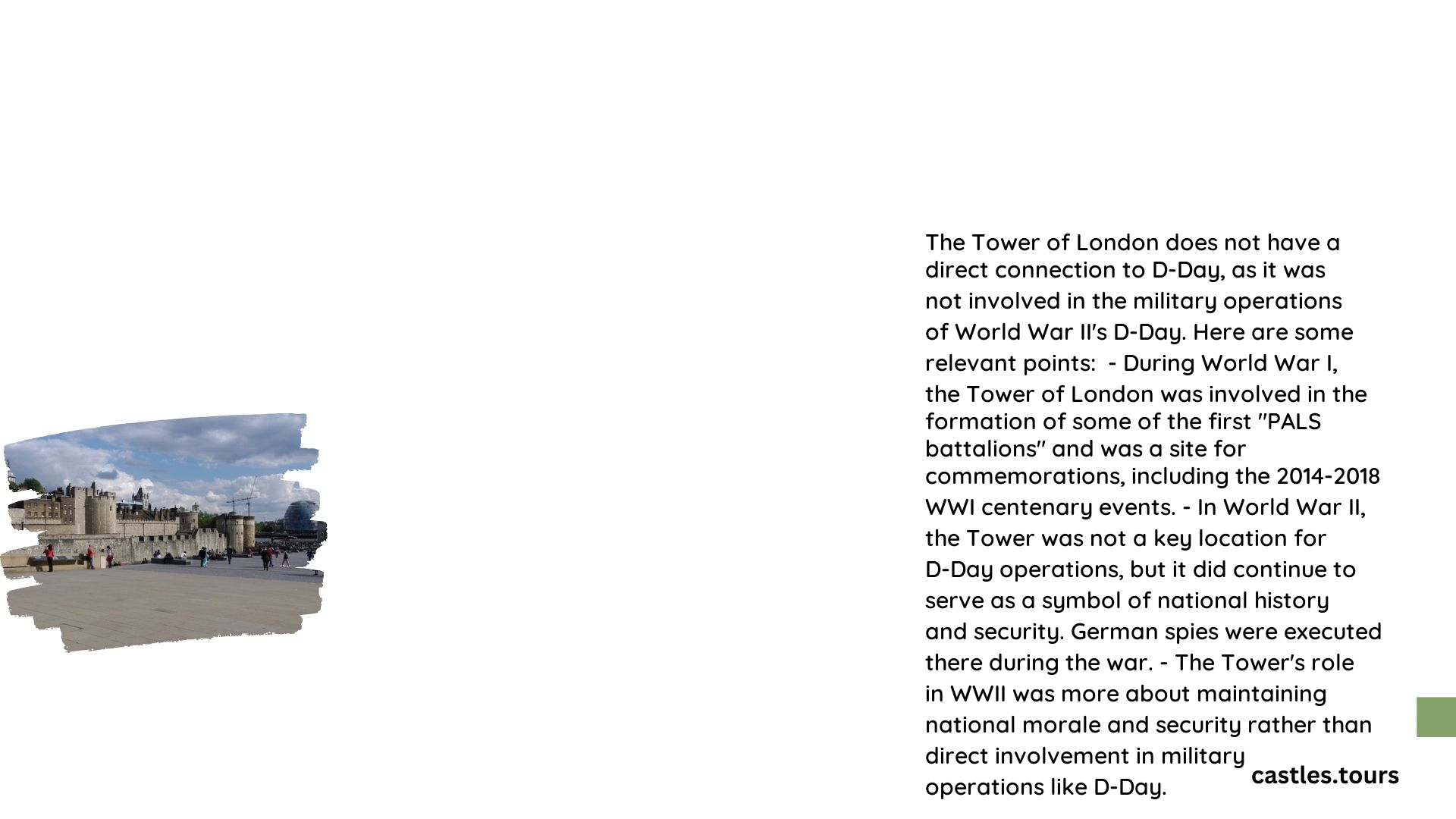The Tower of London, a historic fortress and palace on the River Thames, holds no specific exhibits or events dedicated to D-Day. Built in the 1070s by William the Conqueror, this iconic landmark has served various roles throughout history, including as a royal residence, prison, and home to the Crown Jewels. While not directly connected to D-Day operations, the Tower’s rich military history and significance in English heritage make it a compelling destination for history enthusiasts.
What is the Tower of London’s Connection to D-Day?

Despite its extensive military history, the Tower of London does not have a direct connection to D-Day operations. The fortress’s primary historical significance lies in its roles as:
- A royal palace
- A notorious prison
- An execution site
- An arsenal
- The Royal Mint
- A menagerie
- A public records office
While the Tower played crucial roles in various historical events, its involvement in World War II and D-Day specifically was limited.
How Did the Tower of London Function During World War II?

During World War II, the Tower of London served several functions:
- Military Headquarters: Parts of the Tower were used as administrative offices for military personnel.
- Prisoner of War Facility: The Tower briefly held German prisoners of war.
- Air Raid Shelter: The fortress provided shelter for nearby residents during air raids.
- Safeguarding National Treasures: The Crown Jewels were temporarily moved to a secret location for safekeeping.
However, these roles were not directly related to D-Day planning or operations.
What Can Visitors Expect to See at the Tower of London Today?
While there are no D-Day-specific exhibits, the Tower of London offers a wealth of historical experiences:
- Crown Jewels Exhibition: View the magnificent royal regalia.
- White Tower: Explore the oldest part of the fortress, housing the Royal Armouries collection.
- Medieval Palace: Experience the recreated chambers of medieval kings.
- Yeoman Warder Tours: Join guided tours led by the iconic Beefeaters.
- Tower Green: Visit the site of famous executions.
- Ravens: Meet the legendary birds said to protect the Tower.
What Are the Visitor Information and Opening Hours?
| Information | Details |
|---|---|
| Opening Hours | Typically 9:00 AM to 5:30 PM (last entry at 4:00 PM) |
| Adult Ticket Price | Approximately £29.90 (subject to change) |
| Special Events | Ceremony of the Keys (700-year-old tradition) |
| Accessibility | Wheelchair access available in most areas |
It’s advisable to check the official website for the most up-to-date information on opening hours, ticket prices, and special events.
How Has the Tower of London Influenced English History?
The Tower of London has played a pivotal role in shaping English history:
- Royal Power: Served as a symbol of monarchical authority.
- Political Intrigue: Witnessed numerous plots, imprisonments, and executions.
- Military Stronghold: Functioned as a formidable fortress protecting London.
- Cultural Icon: Became a significant tourist attraction and national symbol.
What Notable Historical Events Occurred at the Tower?
While not related to D-Day, the Tower has been the stage for numerous significant events:
- Peasants’ Revolt (1381): Rebels breached the Tower’s defenses.
- Princes in the Tower (1483): The mysterious disappearance of Edward V and Richard of Shrewsbury.
- Execution of Anne Boleyn (1536): Henry VIII’s second wife met her fate here.
- Gunpowder Plot (1605): Guy Fawkes was interrogated within the Tower’s walls.
How Does the Tower of London Preserve Its Heritage?
The Tower of London maintains its historical significance through:
- Conservation Efforts: Ongoing restoration and preservation projects.
- Educational Programs: Offering insights into various periods of English history.
- Cultural Events: Hosting exhibitions and reenactments.
- UNESCO World Heritage Site Status: Recognized for its outstanding universal value.
What Are Some Lesser-Known Facts About the Tower of London?
- Royal Menagerie: The Tower once housed exotic animals, including lions and polar bears.
- Legendary Ravens: A superstition states that if the ravens leave, the kingdom will fall.
- Salt Tower Graffiti: Prisoners’ etchings can still be seen on the walls.
- Royal Mint: For over 500 years, the Tower produced England’s coins.
How Can Visitors Make the Most of Their Tower of London Experience?
To fully appreciate the Tower’s rich history:
- Join a Yeoman Warder tour for entertaining and informative insights.
- Explore the White Tower’s extensive arms and armor collection.
- Witness the Crown Jewels and learn about their significance.
- Visit during off-peak hours to avoid crowds.
- Attend special events or exhibitions when available.
While the Tower of London may not offer specific D-Day exhibits, its profound historical significance and diverse attractions make it an essential destination for history enthusiasts and tourists alike. The fortress stands as a testament to England’s rich and complex past, offering visitors a unique glimpse into centuries of royal, military, and cultural heritage.
References:
1. HistoryExtra
2. UNESCO World Heritage Centre
3. Historic Royal Palaces
